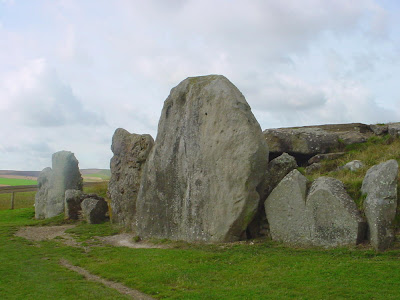
This comment which came up in a book, has lived with me for a long time and I use it in a sense to evaluate what I am looking at when I visit longbarrows or cromlechs, I expect most people do.
The first thing that one notices at prehistoric sites is their landscape, and the question must always come to mind as to why people settled within a particular area. Their stone monuments are supposedly places of ritual and ceremonial enactions, and much energetic modern intellectual speculation is spent on trying to fathom out the reason why. The answer is of course we don't know, their is no written evidence, so what evidence there is to gather must come from archaeological exploration.
Three very famous longbarrows lie within a 40 kilometre distance of my home, Stoney Littleton, West Kennet Longbarrow and Wayland Smithy. All have distinct features and an incredible presence within their modern landscapes, and I suspect the same could be said that when originally built they would also have an awesome effect on the neolithic people.
Making a space in place is marking a home spot, a territory to return to, a place where the ancestors can rest and be visited; a longbarrow by its very presence will accumulate its ancestral stories and folklores.
The first thing to notice about the later Welsh cromlechs, (and taking them as an example )is there very cave-like appearance, this perhaps gives us an inkling of what a tomb, the resting place of ancestral bones was all about. Originally through the much earlier periods of mesolithic and paleolithic man, cave dwelling was part of their lives. Simplistically put, this ancestral link to caves came down through to the neolithic period, and when the longbarrows were constructed out of very solid natural stones, the appearance would have suggested going into a cave. This can best be explained by the fact that the constructed stone chambers only go back a short distance compared to the very long length of the barrow itself, the back soil and turf (the major part) of the barrow in actual fact represents the hill or cliff in which the chamber/ cave is situated now this of course is only a theory......
.jpg)
Wayland's Smithy long earthen structure outlined by stones;
...........................................................................
Stoney Littleton has a different facade, plain, its entrance stones decorated with fossils and the large ammonite stone on the left, but inside the six chambers are very 'cavelike' , and often this is interpreted as a returning to the 'womb' . This statement needs some explaining, it has been suggested that if neolithic people saw the 'earth' as a living body, a mother form, fertility symbol, then returning the dead to the earth/mother, would in some ways keep them alive or renew them. This was after all a primitive culture, that made offerings of flint, pottery, and food into pits and postholes, one presumes in the hope that the earth/mother would make more of this bounty.
Inside Stoney Littleton barrow
 The entrance of Stoney Littleton
The entrance of Stoney Littleton ................................................................
................................................................
West Kennet Longbarrow
Facade and blocking stones of West Kennet when the longbarrow was 'closed down'
 Stoney Littleton is also restored, and was in fact 'closed down' by the neolithic people at some stage by erecting the large blocking stones in front of the entrance and filling up the interior with earth and stones.
Stoney Littleton is also restored, and was in fact 'closed down' by the neolithic people at some stage by erecting the large blocking stones in front of the entrance and filling up the interior with earth and stones.
.jpg)


No comments:
Post a Comment
Love having comments!